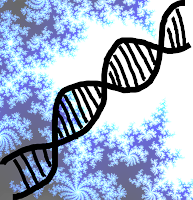Creation Science and Chromosome Fusion
 Scientists operate from their worldviews, so it is entirely reasonable to get a notion and see if there is any evidence to support it. Secular biologists and so forth presuppose goo-to-geneticist evolution. There is a problem with the number of chromosomes between humans and apes, so something "must" have changed.
Scientists operate from their worldviews, so it is entirely reasonable to get a notion and see if there is any evidence to support it. Secular biologists and so forth presuppose goo-to-geneticist evolution. There is a problem with the number of chromosomes between humans and apes, so something "must" have changed.Evolutionists believe that there was chromosome fusion in human history, and that's why apes have a couple more than we do. They have a suspected site for this and papers have been written on it. Many important factors have been overlooked and even ignored, and a creation scientist has done his own research showing that this alleged fusion is yet another tale of mystery and imagination for the Darwin Zone. We were created differently from the animals, pilgrim, and in God's image.
To read more about the truth regarding the fictional chromosomal fusion, click on "Human Chromosome 2 Fusion Never Happened". Also of interest is "Refusing the Fused Chromosomes".One of the more popular arguments used for humans supposedly evolving from apes is known as the chromosome fusion. The impetus for this concept is the evolutionary problem that apes have an extra pair of chromosomes—humans have 46 while apes have 48. If humans evolved from an ape-like creature only three to six million years ago, a mere blip in the grand scheme of the evolutionary story, why do humans and apes have this discrepancy?The evolutionary solution proposes that an end-to-end fusion of two small ape-like chromosomes (named 2A and 2B) produced human chromosome 2 (Figure 1). The concept of a fusion first came about in 1982 when scientists examined the similarities of human and ape chromosomes under a microscope. While the technique was somewhat crude, it was enough to get the idea going.